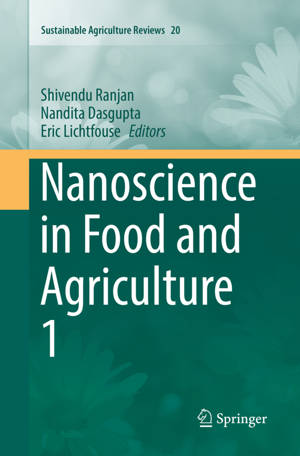
- Retrait gratuit dans votre magasin Club
- 7.000.000 titres dans notre catalogue
- Payer en toute sécurité
- Toujours un magasin près de chez vous
- Retrait gratuit dans votre magasin Club
- 7.000.0000 titres dans notre catalogue
- Payer en toute sécurité
- Toujours un magasin près de chez vous
Nanoscience in Food and Agriculture 1
259,45 €
+ 518 points
Description
Nanotechnology is a fast-evolving discipline that already produces outstanding basic knowledge and industrial applications for the benefit of society. Whereas the first applications of nanotechnology have been developed mainly in material sciences, applications in the agriculture and food sectors are still emerging. Due to a rapid population growth there is a need to produce food and beverages in a more efficient, safe and sustainable way. Here, nanotechnology is a promising way to improve crop production, water quality, nutrition, packaging, and food security. There are actually few comprehensive reviews and clear textbooks on nanotechnology in agriculture, water, and food. In this book there are 10 chapters describing the synthesis and application of nanomaterials for health, food, and agriculture are presented.
Nanomaterials with unique properties will dramatically improve agriculture and food production. Applications will include nanofertilisers to enhance plantgrowth and nanosensors to detect food contamination. An overall view of nanotechnology applications in agriculture, food, water, and environment are described in the first two chapters by Dasgupta et al. and Singh. Health and environmental applications of nanotechnology are presented in chapters 3-5. Shukla and Iravani review green methods to synthesize metal nanoparticles, and give applications to water purification, in chapter 3. The removal of up to 95% of contaminants by nanoparticles, nanotubes and nanostructured membranes is described by Naghdi et al. in chapter 4. Yoti et al. then review nanosensors for the detection of pathogenic bacteria in chapter 5. Those nanosensors can be used as biodiagnostics to control food and water quality. Food applications of nanoscience are presented in chapters 6 and 7 by Kuswandi and Sarkhar et al. Kuswandi explain in chapter 6 that nanomaterials can improve packaging quality and that nanosensors can detect freshness and contanimants. The use ofnanoparticles to protect ingredients such as vitamins, flavours, and antimicrobials is reviewed by Sarkhar et al. in chapter 7.
Nanomaterials with unique properties will dramatically improve agriculture and food production. Applications will include nanofertilisers to enhance plantgrowth and nanosensors to detect food contamination. An overall view of nanotechnology applications in agriculture, food, water, and environment are described in the first two chapters by Dasgupta et al. and Singh. Health and environmental applications of nanotechnology are presented in chapters 3-5. Shukla and Iravani review green methods to synthesize metal nanoparticles, and give applications to water purification, in chapter 3. The removal of up to 95% of contaminants by nanoparticles, nanotubes and nanostructured membranes is described by Naghdi et al. in chapter 4. Yoti et al. then review nanosensors for the detection of pathogenic bacteria in chapter 5. Those nanosensors can be used as biodiagnostics to control food and water quality. Food applications of nanoscience are presented in chapters 6 and 7 by Kuswandi and Sarkhar et al. Kuswandi explain in chapter 6 that nanomaterials can improve packaging quality and that nanosensors can detect freshness and contanimants. The use ofnanoparticles to protect ingredients such as vitamins, flavours, and antimicrobials is reviewed by Sarkhar et al. in chapter 7.
Spécifications
Parties prenantes
- Editeur:
Contenu
- Nombre de pages :
- 324
- Langue:
- Anglais
- Collection :
- Tome:
- n° 20
Caractéristiques
- EAN:
- 9783319818627
- Date de parution :
- 14-06-18
- Format:
- Livre broché
- Format numérique:
- Trade paperback (VS)
- Dimensions :
- 156 mm x 234 mm
- Poids :
- 485 g

Les avis
Nous publions uniquement les avis qui respectent les conditions requises. Consultez nos conditions pour les avis.





